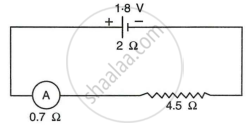Advertisements
Advertisements
प्रश्न
A cell supplies a current of 0.6 A through a 2Ω coil and a current of 0.3 A through on 8Ω coil. Calculate the e.m.f and internal resistance of the cell.
उत्तर
Given: I1 = 0.6 A, R1 = 2 Ω and I2 = 0.3 A, R2 = 8 Ω
Let the e.m.f. of the cell is E and its internal resistance is r.
From I = `"E"/("R + r")`
0.6 = `"E"/("2 + r")` and `0.3 = "E"/("8 + r")`
∴ E = 0.6 (2 + r) = 1.2 + 0.6 r and
E = 0.3 (8 + r) = 2.4 + 0.3r
Thus, 1.2 + 0.6r = 2.4 + 0.3r
or 0.6r - 0.3r = 2.4 - 1.2
Or 0.3 r = 1.2 or
r = `1.2/0.3 = 4 Omega`.
and E = 1.2 + 0.6 × 4 = 1.2 + 2.4 = 3.6 V
APPEARS IN
संबंधित प्रश्न
Explain why the p.d across the terminals of a cell is more in an open circuit and reduced in a closed circuit.
A cell is used to send current to an external circuit.
- How does the voltage across its terminals compare with its e.m.f.?
- Under what condition is the e.m.f. of a cell equal to its terminal voltage?
A battery of e.m.f 3.0 V supplies current through a circuit in which the resistance can be changed.
A high resistance voltmeter is connected across the battery. When the current is 1.5 A, the voltmeter reads 2.7 V. Find the internal resistance of the battery.
A cell of e.m.f. 1.8V and internal resistance 2Ω is connected in series with an ammeter of resistance 0.7Ω and a resistor of 4.5Ω as shown in Fig.

- What would be the reading of the ammeter?
- What is the potential difference across the terminals of the cell?
A cell of e.m.f. 2 V and internal resistance 1.2 Ω is connected to an ammeter of resistance 0.8 Ω and two resistors of 4.5 Ω and 9 Ω as shown in following figure.

Find:
- The reading of the ammeter,
- The potential difference across the terminals of the cells, and
- The potential difference across the 4.5 Ω resistor.
What is the colour code for the insulation on the earth wire?
Define the e.m.f. (E) of a cell and the potential difference (V) of a resistor R in terms of the work done in moving a unit charge. State the relation between these two works and the work done in moving a unit charge through a cell connected across the resistor. Take the internal resistance of the cell as ‘r’. Hence obtain an expression for the current i in the circuit.
(a) Calculate the total resistance across AB.

(b) If a cell of e.m.f 2.4 V with negligible internal resistance is connected across AB then calculate the current drawn from the cell.
Explain the meaning of the term internal resistance of a cell.
A battery of e.m.f. 6·0 V supplies current through a circuit in which the resistance can be changed. A high resistance voltmeter is connected across the battery. When the current is 3 A, the voltmeter reads 5.4 V. Find the internal resistance of the battery.
